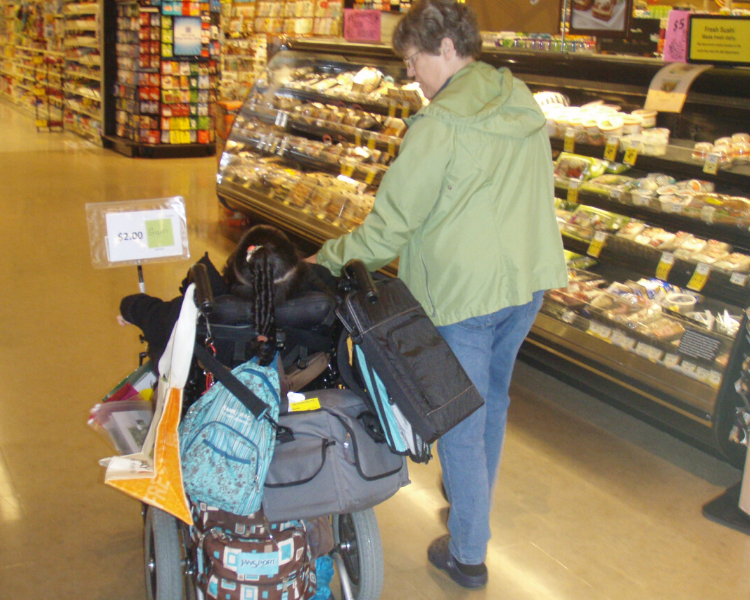Miranda's Journey: Preparing for Employment–Successes and Challenges
Miranda entered my program as a 9th grader and like most teenagers seemed uninterested in me—her teacher—and my plans for her. She is nonverbal, deaf-blind, and has limited mobility, but I could tell she was disinterested by the way she would turn up her nose or push me away when I’d try to work with her. Behind her “stubbornness,” though, I could see a fire in her eyes. A determination. I love a challenge and knew that working with Miranda would challenge me in ways I’d never been challenged before.
Before I continue, I’d like you to know a little more about Miranda. She was born with a rare disability called Marshall-Smith Syndrome (MSS), a childhood condition involving specific facial characteristics, bone maturation beyond what is expected for an individual's age, failure to grow and gain weight, and severe respiratory problems.
In addition to MSS, Miranda has vision impairments and cholesteatomas in her ears. She is almost completely deaf in her left ear. The cholesteatomas are growing and there is no hope for removal. She has severe osteopenia and seizures and requires 24-hour nursing care
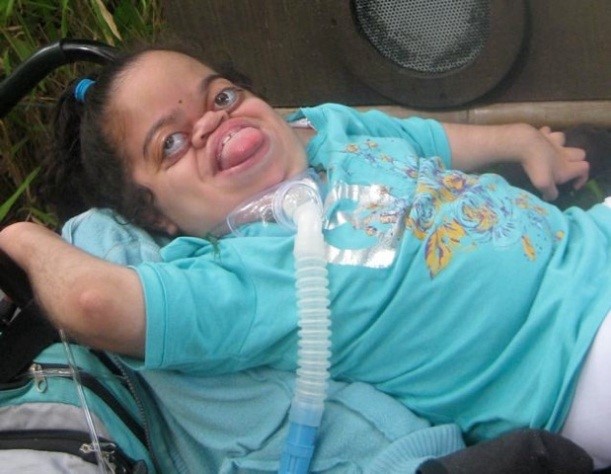
Recognizing and Responding to Miranda’s Abilities
When I first met Miranda, she was 14 years old and communicated by choosing from options presented on communication partners’ hands. For example, “Do you want to go to the library” (partner holds up left hand) “or the music room?” (partner holds up right hand). Similarly, when working on academics, she would point to an answer when presented with two choices.
This limited two-choice communication system made it difficult to determine if Miranda really picked what she meant to pick or just happened to make a lucky guess. Her mom and school nurses, Lynne and Darcy, knew she was capable of much more.
Our educational team and came up with the idea of using a yardstick to present three choices instead of two. We tested it by assessing her sight word vocabulary using enlarged text attached to the yardstick with Velcro.
Amazingly, Miranda was able to identify 13 sight words right away. We knew this did not occur by chance because each was presented three different times, in three different formats (uppercase, lowercase, first letter capitalized), and in three different positions (left, right, middle). Lynne, who had worked with Miranda for 10 years at the time said, “I had no idea she knew those words. But why shouldn’t she? She’s been on this earth for 14 years and is bound to have picked up information and knowledge we have no idea about.”
This was a wake-up call for Miranda’s entire team. We conducted assessments and set up programs for her in other academic areas. Now that she had an outlet to show what she was capable of, her confidence grew. She moved from a passive, seemingly disinterested teenager, to a bright-eyed, motivated, much more engaged student.
Miranda, who previously would turn away when approached, began to reach out to others, as if to say, “I have something to tell you.” We turned this gesture into a means of communication and encouraged her to take the hands of educators and peers and lead us first around the classroom, and later, the school. Eventually, she would lead us to get and put away her materials, find the people she was supposed to work with, accomplish her job tasks, check her schedule, find items to shop for at the store, and more.
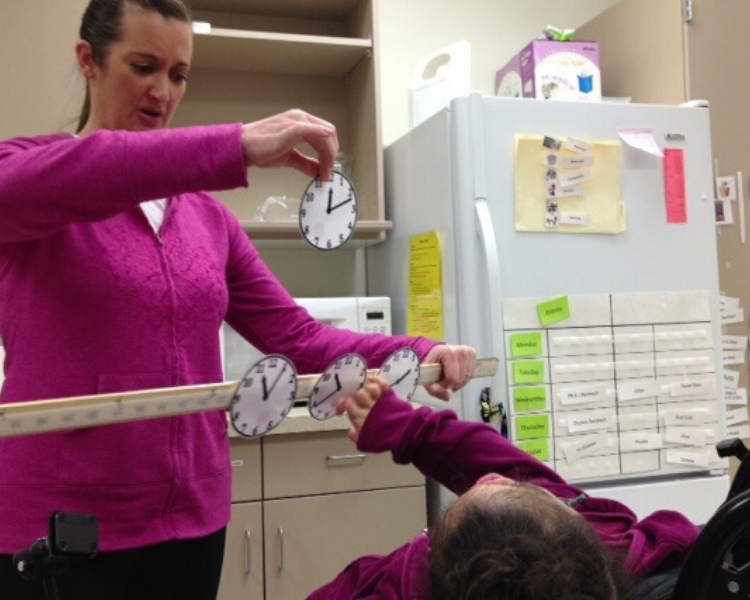
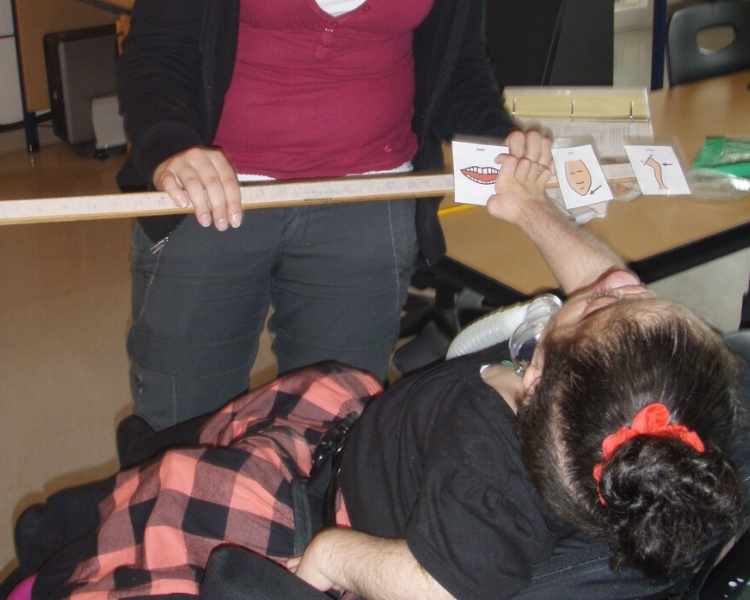
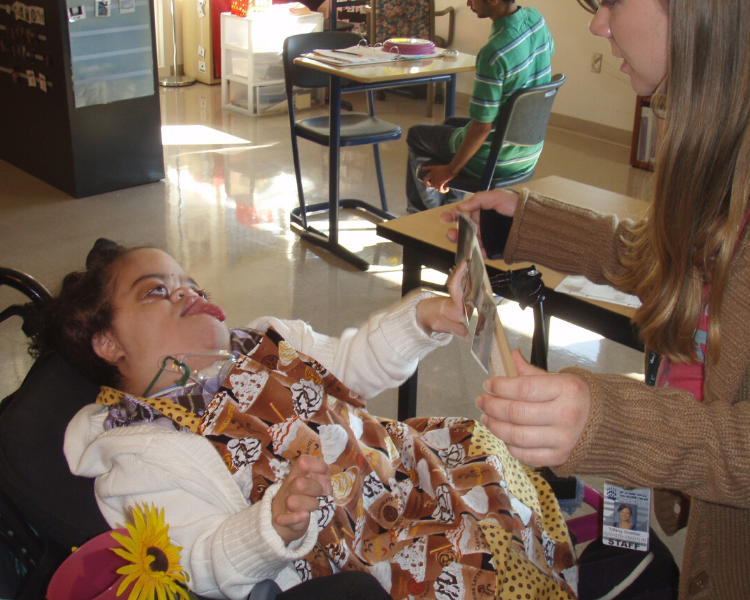
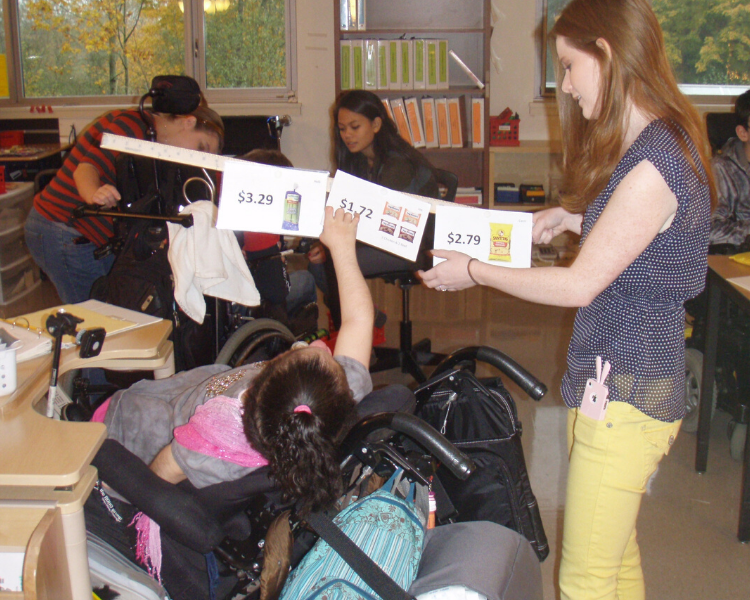
Expanding Communication
We quickly realized just how social Miranda was and how much she loved to “be in charge.” We knew we had to figure out a way to put these amazing skills to work.
Our class went on community outings at least once a week, usually to the grocery store to buy items for lunch. Since Miranda is tube fed and doesn’t eat by mouth, it didn’t make sense for her to shop for groceries. However, we wanted her to use money skills outside of the classroom. Her mom came up with the idea of having her buy a special item for her brother once a week. She picked out the items and presented them to him. She really enjoyed doing this, so we decided to have her buy items for staff members. This new job allowed us to combine multiple academic skills with an abundance of communication and social opportunities. We set it up to provide her with as many choices as possible, putting her in complete control. With every new opportunity, we saw her self-confidence grow.
At that time, Miranda still didn’t have a formal communication system, so we began using a Step-by-Step Communicator. It was simple, available, and could be positioned on a table to her side, making it easy for her to access. She quickly showed us, however, that the Step-by-Step was too simplistic for her needs, so we explored other options. This was around the time that iPads became popular for communication and the Proloquo communication app was introduced. It seemed perfect for her—that is, until we tried to position it in a way where she could see it, hear it, and access it at all times.
Because of Miranda’s complex health issues, she must be positioned in a very specific way. In addition, she has multiple pieces of medical equipment attached to her wheelchair for daily needs and emergencies and it’s critical that these items are never blocked. We also had to consider her vision impairment, the fact that she was deaf in her left ear, and her decreasing range of motion due to the nature of her disability.
As her teacher, I was beginning to get discouraged. Fortunately, Miranda is extremely tenacious. In her own way, she showed she was not going to let us give up. Additionally, she has an incredible family and team who were dedicated and willing to do whatever it took to make this work. I knew that if we stood a chance of figuring something out, I was going to need the help of every member of my amazing team.
We found a time that worked for everyone and all nine of us gathered around Miranda and began experimenting with various mounting devices and holders:
- The speech and language pathologist ensured that the communication program was appropriate for Miranda’s communication needs.
- The physical therapist made sure the tablet was positioned in a way that she could physically access it.
- The occupational therapist made sure the icons were the right size.
- The teacher of the visually impaired evaluated the screen presentation (e.g., visibility of icons, appropriate contrast, minimal glare).
- The audiologist made sure the iPad’s voice output was sufficient for Miranda to hear.
- The school nurses checked to see that the medical equipment wasn’t blocked and to offer general suggestions.
- Her mom brought all the previous mounting and communication devices that had been tried over the years in case one of them would help.
- Her classroom teacher discussed programming and how to teach Miranda to access her iPad and embed its use throughout the school day.
- Miranda was there for obvious reasons and to voice her opinion.
If we hadn’t worked as a team, with all related service providers and the family in attendance, Miranda would not be communicating today. Each specialist brought a unique and critical perspective.
In the end, we determined that no mounting device would meet all of Miranda’s needs, but once again, the team refused to give up. We met on an ongoing basis to brainstorm possibilities. In the meantime, we held the iPad for Miranda in just the right position for her to access and obtained a special iPad case that made it easier for us to manage. We provided an icon that she could press at any time to request the iPad, so it was always available to her. We used a mesh bag that held a Bluetooth speaker that was loud enough for her to hear and could be easily placed on counters or tables for others to hear in loud environments. We positioned her wheelchair away from windows to avoid glare. We offered our hands as guidance when she was feeling tired. She pushed them away when she didn’t need us.
Five years later, we are still looking for an effective mounting device, but Miranda uses her iPad effectively, fluently, and proudly. The reason we continue to seek a better solution is because she greatly values her independence. Even though she is totally in charge of her iPad, it can appear as though the person holding it or supporting her hand is the one in control. It’s obvious that this bothers Miranda. In fact, in her own way, she asked Lynne to put an introduction on her iPad so she can tell people she meets that she is the one in charge: “Hello, my name is Miranda and this is my assistant. I don’t have a speaking voice so I use my iPad. I understand everything you say and I’d love to chat with you.”
Clearly, Miranda needed to learn how to use the iPad to communicate before she was able to get to this advanced level. We began by printing the Proloquo symbols and placing them on the yardstick. We introduced symbols receptively at first, beginning with the most motivating choices. It didn’t take long for her to figure out what the symbols meant, since each brought her something she loved.
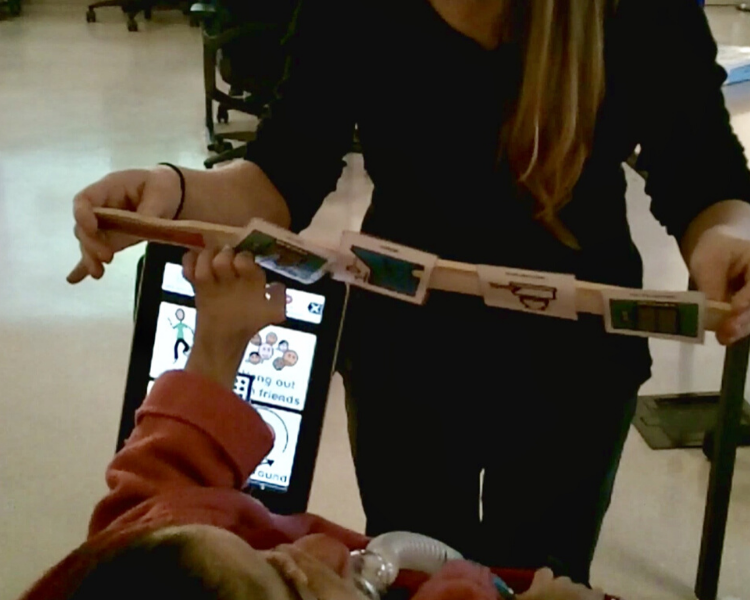
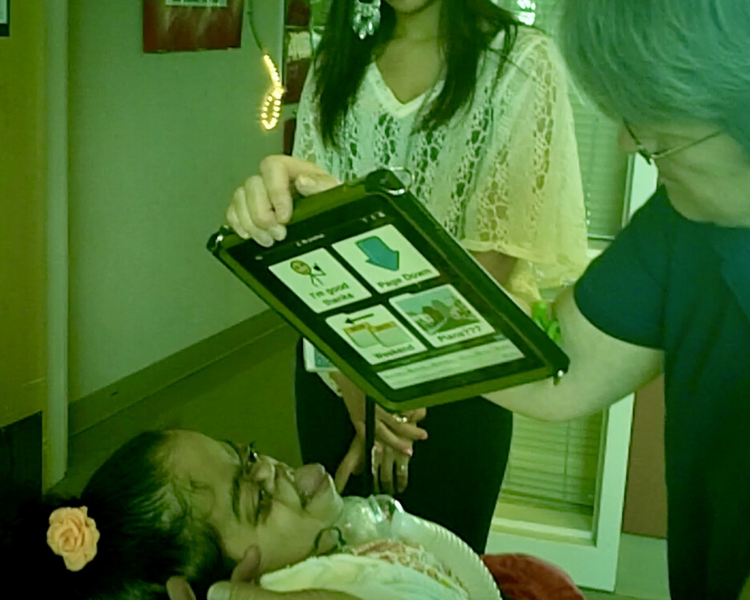
Embedding Job Readiness Skills into Daily Instruction
As noted above, we began building Miranda's job skills by having her buy items for staff members at the grocery store. This job, combined with her enhanced communication system, brought her so much joy that we decided to expand it. She had been taking grocery orders on Monday and shopping and delivering groceries on Tuesday. She now began to also take coffee orders on Wednesdays and make trips to Starbucks and coffee deliveries on Thursdays.
In the beginning, we combined as many academic programs with her job as we could. For example, using modeling and a lot of repetition, we taught Miranda to tell staff how much money they owed and then have them count it out. The following video was taken on the first day that Miranda used a Step-by-Step Communicator (this was prior to the introduction of the iPad) and shows how we introduced the concept of counting money.
The Step-by-Step Communicator allowed Miranda to say two messages—"Do you want anything from the store tomorrow?” and “Okay, thank you.” The same staff members assisted her with the same tasks each day to provide consistency and establish relationships.
Whenever Miranda behaved in an unfamiliar way, we would acknowledge that we knew she was trying to tell us something and begin guessing. If we were wrong, she would keep a straight face and turn her head away. When we were correct, she would smile and belly laugh with delight. Sometimes it took months to figure out what she was telling us, but Miranda never gave up. As long as we acknowledged each time she did something out of the ordinary, guessed a few times, and reassured her we would try again tomorrow, she would finish her job that day and try again the next.
Here's an example. After implementing the money program shown in the video, Miranda began to hit the card with the model of a bill on the end of the yardstick with more force than usual. After she patiently repeated the same action over many days, we realized she was telling us she didn't need the model anymore. We took it away and sure enough she could count the money perfectly without it. This was the first of many times she modified her own programs.
It’s easy to assume that children and adults with significant disabilities are not able to communicate; therefore, our expectations are low. After this experience with Miranda, I began to think that perhaps the fact that she had reached high school without having a formal means of communication, had more to do with us not listening or understanding than with her not being capable. I began to wonder about my other students. How many have repeatedly communicated only to be (unintentionally) ignored? How many have given up? Were they not communicating or was I not understanding? Did I set my expectations too low and develop instructional programs based on assumptions?
At this point, I learned to close my mouth, listen, and set aside what I thought I knew. We began videotaping Miranda to see if we could pick up more subtle communication cues. Her communication and our understanding increased exponentially. As we took the time to listen, understand, and read her behavior as communication, she began to trust us more. Her willingness to try new devices and experiences was incredible. The same was true for other students. The more we invested, observed, and were willing to think outside the box, the more they flourished.
Preparing for Work After High school
At this stage in Miranda’s school career, we needed to think about how her job would transfer to life after school. She clearly preferred the coffee job to the grocery job. She loved the response she received when she arrived with the highly anticipated coffee orders and figured out ways to include more people and create shortcuts and modifications that made her job more efficient and effective.
The Starbucks Miranda went to was more than willing to accommodate her. When they saw us coming, they would bring another staff person to help at the register so Miranda wasn’t rushed, and other customers weren’t waiting on her. They allowed her to take as much time as she needed. Her nurse put her Bluetooth speaker on the counter so the clerk could hear Miranda’s orders.
As you can see, her job was very specific to the staff in the classroom. We experimented with ways to make her routine adaptable to other locations and contacted additional Starbucks locations to see if they would be willing to accommodate her.
Due to her medical needs, Miranda’s IEP team decided to keep her in high school following her senior year, rather than send her to an 18 through 21 transition program. As part of the county’s school-to-work program, she was assigned a job coach from a local employment vendor and a vocational rehabilitation counselor. We hoped to work with this program to continue Miranda’s coffee job using a customized employment approach.
The year Miranda graduated was my last year of teaching. I left to become a full-time educational consultant. To continue to support Miranda, I remained a member of her IEP team as an advocate. We decided to have her deliver coffee to my new office so she could meet new people and experience a new location.
Miranda and her team encountered many challenges in attempting to gain employment for her. It had taken years for current team members to truly understand her and establish relationships and it was difficult for a new person to step into a job development and coaching role. The person assigned to Miranda was motivated and eager to assist but had limited time with Miranda—not nearly enough to really get to know her.
Because of Miranda’s medical condition, it’s nearly impossible for her to keep regular hours and work in typical employment settings. If she got a cold, she could be out of work for a month or more. If she had a seizure or other issue while at work, she would have to leave abruptly. In addition, her job must be close to home and her hours revolve around her personal needs. If Miranda were to get a job and make too much money, it would affect the services she receives.
Taking all these factors into consideration, her job coach was able to find her a job at a local restaurant delivering lunches. The restaurant was wonderful and willing to not only accommodate Miranda but create a new delivery position. It seemed like a perfect solution!
Unfortunately, because of her limited hours and sporadic schedule, she was not able to build a clientele. She worked for several months and never once delivered a lunch. The restaurant tried to find other tasks for her, typically cleaning tables, but because Miranda couldn’t be around chemicals this meant her nurse cleaned tables for an hour or two a week while Miranda sat and watched. The job dissolved over time.
Since then, Miranda has come to local trainings I offer to take orders and deliver coffee, but this occurs only a couple of times per year. She has also delivered coffee to teachers in extended school year programs in the summer, but again, this has been limited to once or twice a year.
Miranda absolutely shines when given the opportunity to work and takes an incredible amount of pride in her job. Even if she hasn’t done it in months, she ensures everything goes exactly as it should, remembering tiny details the rest of us have forgotten. It’s clear she’s doing exactly what she was meant to do. Imagine if she could do this more than just a few times per year.
Miranda is incredibly social. She needs an environment where she can socialize, utilize her skills, and contribute to her community. She doesn’t care about making money. She cares about people, providing a service, and making connections. She is miserable when she is isolated, and yet her happiness is dependent on having a system that works for her.
What is Needed
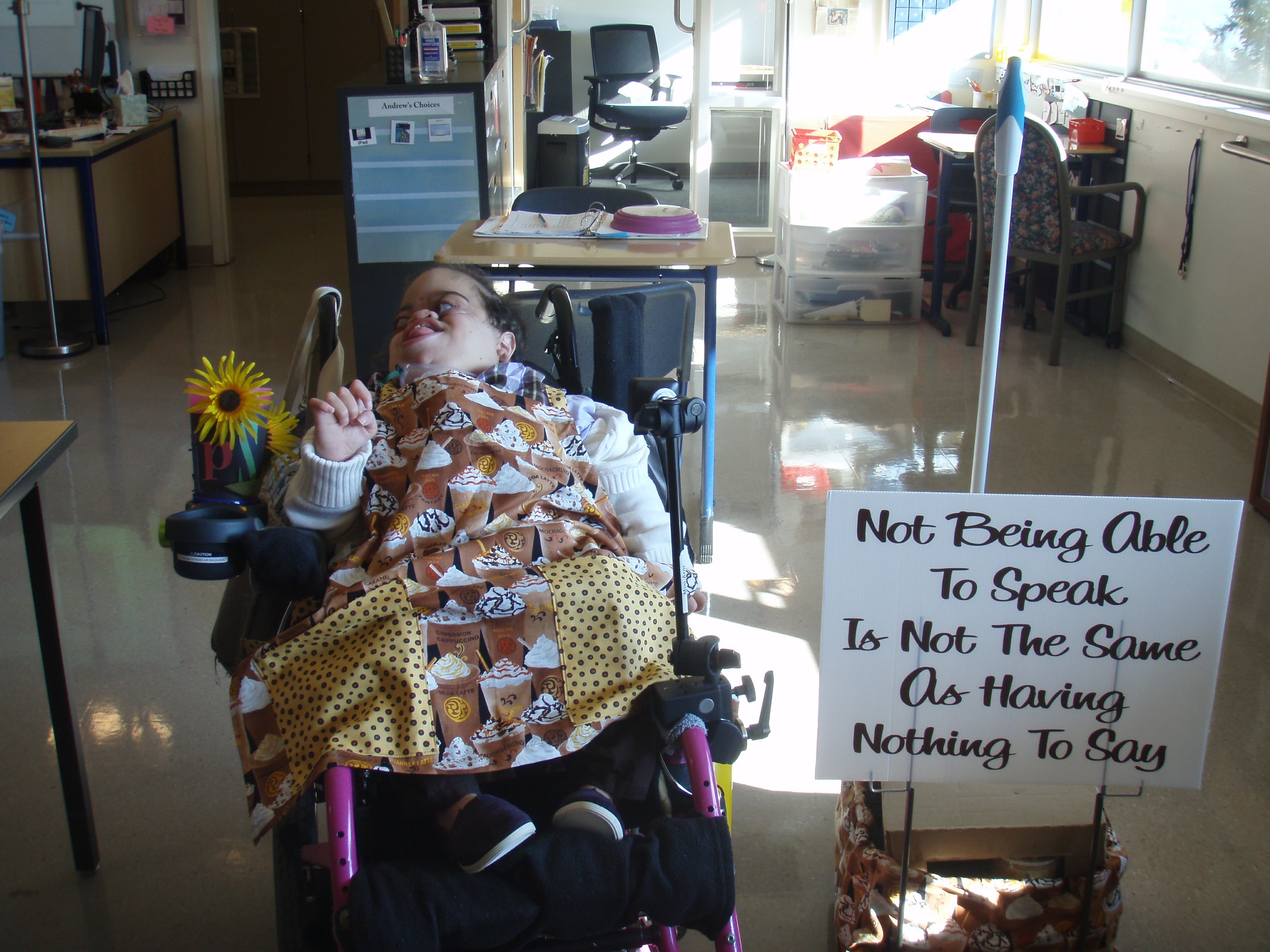
In an ideal world, Miranda would have her own coffee business. She even has a name for it, Jittery Jalopy. She would have a few consistent places a week where she would show up to take and deliver coffee orders. This would be a luxury for her customers. Something they would get excited about and appreciate, but not depend on, making it okay for Miranda to be gone for a few weeks at a time and return when she was able. She could work off tips to pay for the gas in her van to get her to and from work.
It sounds simple, but who will set this up? Does she need a business license? A food handler permit? Who will program her iPad? Who will provide additional supports? Who will make arrangements with a local Starbucks or other coffee shop? Who will train other nurses? When Miranda’s job at the restaurant dissolved, so did her relationship with the employment agency. They were required to find her a paid job and were not able to assist with volunteering or self-employment.
Miranda’s parents are exhausted from 23 years of fighting and advocating. They both work full-time and have other children and grandchildren. Her nurses are not comfortable doing job development, creation, and set-up. I run my own business which requires lots of hours and travelling. We all have the best intentions and are doing as much as we possibly can, given our current circumstances, but once again Miranda is at our mercy.
It shouldn’t be this difficult. I believe the system will continue to change for the better. With advancements in technology and medicine, young men and women with significant disabilities are living much longer lives. As a society, we must evaluate how we can assist these amazing young adults to not only live longer lives, but live lives filled with meaning and purpose. They have so much to offer. Miranda has never given up in the past and I hope she will not give up now.
When I think about my time as a job coach, residential provider, recreational specialist, special education teacher, and now educational consultant, I reflect upon what I’ve learned, what I know, and what I can share with others. I’ve come to realize that it’s not about me and my knowledge, but who I’ve met and what they’ve taught me. I’ve had several defining moments, but it all began with this incredible young woman.
A message to Miranda...
You are outrageously tenacious, persistent, patient, and clever. You have far surpassed every expectation and goal I’ve dreamt for you. You have shown me what an amazing communicator and independent young woman you are despite the challenges life has presented. You have been through more pain and adversity in your 23 years than most people have in a lifetime, and yet you continue to smile, laugh, and persevere. You have touched my heart, and I know you will continue to make a difference in the lives of all you encounter. Thank you for allowing me to share your story!
